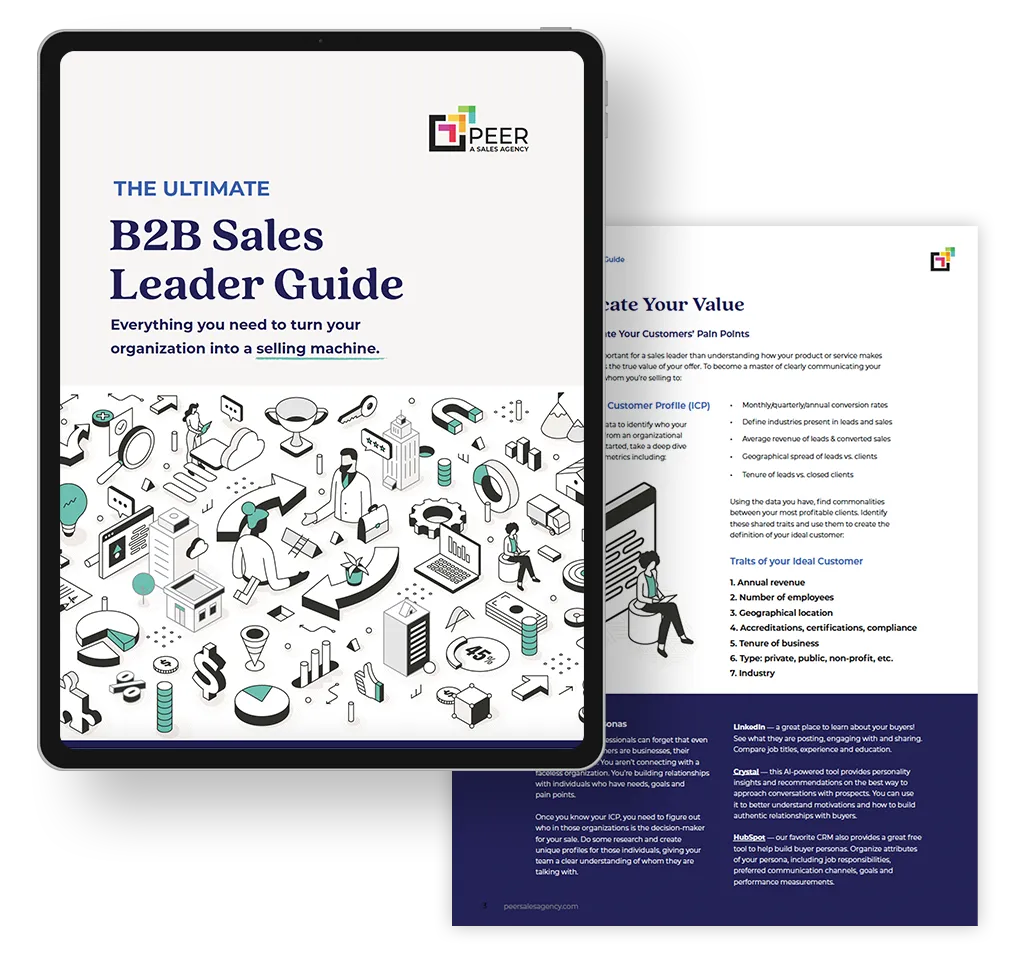Leads are great. Qualified leads are better.
Your sales team spends a lot of time building their network, nurturing leads, and finding COIs to help them get in front of decision-makers. The last thing they need is more noise — which is why lead qualification is paramount if you want your sales team to have the right conversations with the right people to drive revenue.
It’s all about efficiency gains. By implementing a solid, consistent lead qualification process, you can ensure that your sales team focuses their efforts on high-quality leads that are most likely to result in closed deals.
Let’s dive in and explore the right qualification process to better identify potential customers and streamline your sales cycle:
First Things First: Defining a Marketing Qualified Lead
Not all leads are created equal. That’s why it’s important to define what a Marketing Qualified Lead (MQL) is right from the start. In the simplest terms, an MQL is a lead that fits your ICP and Persona targets, and has shown a certain level of interest and engagement with your brand or product. This makes them more likely to be ready for a sales conversation.
Does the lead work in a company that fits your Ideal Customer Profile?
Assessing whether a lead works in a company that fits your Ideal Customer Profile (ICP) is step one. If a lead doesn’t work for a company that fits your target, they’re a waste of time.
1. Know your ICP by heart: Understand the key characteristics and attributes that define your ideal customer. This may include industry, company size, location, budget, or specific pain points. Be clear about what criteria the lead’s company must meet. Don’t waver.
2. Research the lead’s company: Gather as much information as possible about the lead’s company before engaging further. Explore their website, social media platforms, and any other available resources. Look for indicators that demonstrate alignment with your ICP, such as their target audience, market presence, or industry specialization.
3. Evaluate relevance and fit: Do your best to determine if the lead’s company has a genuine need or desire for your product or service. Can your solution effectively address their pain points or fulfill their requirements?
This targeted approach allows you to focus your sales efforts on the right prospects. Remember to regularly reassess and refine your ICP as your business evolves to ensure continued success.
Does the lead have a job title or role that matches your buyer persona?
Once you’ve established that the lead works in a company that fits your ICP, it’s time to make sure that the potential buyer actually fits your persona. Even if the lead works for a perfect-fit company, if they’re not in the decision-maker seat, they’re unlikely to be an MQL.
Business intelligence tools like Clearbit by Hubspot, Apollo, or Sales Navigator from LinkedIn are a great place to start. Even without these paid tools, you can often just run a simple search on Google or LinkedIn to find a lead’s job title.
However you find it, ensure that the lead is in a position that aligns with your established persona.
Getting an Initial Conversation Booked
If a lead has shown interest in your solution, fits your ICP, and they’re aligned with your persona, you’ve got yourself an MQL! Now, it’s time to sharpen your focus and provide more marketing touches and nurturing to drive them to a conversation with your sales reps.
That first conversation is an opportunity to make a strong first impression, establish rapport, and lay the foundation for a beautiful business relationship. Getting this initial conversation booked can sometimes be a challenge. Your marketing materials need to continually educate and nurture prospects until they’re ready to talk to your sales team.
Buyers have become extremely savvy, and they don’t want to be sold at. Buyers will reach out to sales when they’re ready and not a second before. It’s the job of your marketing & sales enablement to warm those leads up and give them everything they need to make their decision.
Craft Engaging and Personalized Outreach:
- Avoid generic or overly-templated messages and show genuine empathy for their pains and problems.
- Put out a range of content that touches on different aspects of the pain and is relevant to each stage of the funnel.
- Keep the message concise, clear, and focused on the solutions to your prospects’ problems.
- Don’t rely solely on email. Consider reaching out through other channels like phone or LinkedIn.
- Personalize each interaction to show that you’ve done your research.
- Be persistent, but respectful, in your follow-ups to increase the chances of getting a response.
When it comes to your MQLs, it’s important to keep in mind the idea of “deposits” and “withdrawals.” When you provide a piece of valuable content, you’re making a deposit. Let’s say those are worth about five cents. When you ask your lead for something, like a meeting or their information, you’re making a withdrawal. Those are worth five dollars.
You’ve got to balance the books. That means making a lot more deposits than withdrawals. Plus, most of the decision-making process is already done before your sales team gets involved. Lead nurturing is one job your marketing team needs to handle for your sales organization to feed new leads into the sales pipeline.
Adding value for the prospect in the initial meeting
Even when your sales leads are warmed up, they’ll still need a compelling reason to book a meeting. Prospects are constantly bombarded with meeting requests from salespeople promoting their products and services.
This approach is often ineffective and unlikely to result in many successful meetings. To stand out and make a meaningful impact, your sales team should offer the prospect something of real value in the initial meeting.
Step away from the pitch deck. This initial meeting is not an opportunity to pitch. This is the time to flex your “help first” mentality. Understand and address the prospect’s pain points and challenges. Provide valuable insights, solutions, expertise, and recommendations that genuinely help the prospect solve their own problems.
Give it away, give it away, give it away now
Everyone likes to get something for nothing. Show your prospects a helpful tool (and send them their own copy) or get them set up for a free trial of your software in your initial meeting. Demonstrate the worth of your services and entice them to take that next step with:
- A free service: Offer your expertise and advice to prospects and execute a sample project or service for them.
- Demo or trial versions of your software or product: Allow prospects to experience firsthand the benefits and features of your product, helping them understand its potential impact on their business.
- Access to exclusive webinars or online courses: Provide educational resources that address common pain points or challenges in your industry, establishing yourself as a thought leader.
Remember, the key is to provide something that aligns with your prospects’ needs and positions your business as a reliable solution.
In the Initial Meeting, It’s 90% About Them, 10% About You
You’ve landed a meeting. Congratulations! Now, rather than bombarding the prospect with information about how great your solution is, this is the time to listen. What are their challenges, concerns, and aspirations? Uncover and understand the pain they’re experiencing.
This initial conversation might be your only opportunity to establish a connection and build rapport with the prospect. By focusing on their pain, you show that you’re invested in finding the right solution for them, even if it means recommending a different option or provider. This not only helps to foster trust, it also allows you to determine whether your product or service aligns with that prospect’s specific needs and wants.
Waste No Time With Problem-Solution Alignment
Remember, for long-term growth, it’s not just about making this sale. It’s about providing a solution that fully solves a prospect’s problem and delivers tangible benefits. That’s how you create a raving fan, one that refers you new business and stays with you for years to come.
If a prospect comes to you and they want a certain service or a product that does a certain job, but one that you don’t exactly provide, this is not an opportunity to agree to the improbable just to close a deal. You’re setting up an expectation that the value you’re promising will be exponentially greater than your service team or product is able to provide.
For example, Peer provides marketing to enable sales teams. Peer doesn’t make television commercials. Even if a prospect came to me tomorrow and said they wanted to invest $250K in television commercials next year, I’d decline the business. Why?
- We don’t do TV commercials. We have partners we can recommend, but this is not part of our core competency.
- The ROI this business is likely looking for on that production is justifiably exorbitant. That requires the very best production agency in that industry, and that’s not who we are.
Even though commercials are marketing assets, this prospect’s needs don’t align with our solution. If I agree to take that business, and just force my service & creative teams to try, I’m setting everyone up for failure. The runway for delivering results is short, and our solution isn’t a good fit for this need. So, the client will be underwhelmed, the team will be stressed out, and the client will churn. That client is burned. Then… that client’s entire network is burned. No referral business. No growth.
The short-term gain is never worth the long-term impact.
It’s better to turn away wrong-fit customers than make empty promises that you or your product can’t deliver. By focusing on solving the right problems for the right customers, you can provide a high-quality solution and maintain your reputation in the market.
Establishing Sales Qualification in Your Initial Conversation
In this initial meeting, you need to ask the right questions and actively listen to the responses to uncover qualifying information without beating your prospect over the head with an interrogation.
1. Research Before the Meeting: Familiarize yourself with their industry, the challenges they may be facing, and any recent news or developments at the company. This helps you ask more insightful questions and position yourself as a knowledgeable helper. Obviously, it’s also important to have a clear understanding of your own product or service, your core message, and the key benefits that relate to this prospect.
2. Avoid Yes/No Questions: During this initial conversation, focus on asking open-ended questions that encourage the prospect to elaborate on their needs and goals. Open-ended questions allow you to understand the prospect’s pain points, priorities, and objectives more comprehensively. This information will help you determine if your product or service aligns with their requirements and desires.
3. Listen More Than You Talk: Active listening is the key here. Show genuine interest in the prospect’s responses and actively engage in the conversation. Focus on what the prospect is saying, and use their answers to guide the conversation. By actively listening, you can pick up on key details, pain points, and opportunities that can help you assess the prospect’s qualification status accurately.
4. BANT: Qualified Based on Budget, Authority, Need and Timeline
After the call, assess if their pain points align with the solutions your product or service offers. Determine if they have the financial means to purchase your solution and if their timeline matches yours for a potential sale. Was this person the actual decision maker, or just an influencer? This evaluation is crucial to ensure you’re working on the best leads first.
Remember, not every prospect is a fit for your business, and that’s okay. It’s better to disqualify early rather than wasting time on prospects who are not likely to convert.
Beyond BANT: Using Current Clients as Your SQL Benchmark
The BANT (Budget, Authority, Need, Timeline) qualification framework has long been a go-to approach to transition an MQL to Sales Qualified Lead (SQL) status. You can go beyond BANT criteria, however, to start finding ideal fit leads you know you can help succeed.
Look for patterns and similarities among your clients. What industry do they belong to? What are their pain points and challenges? Analyze their demographics. Understand the common attributes of your successful customers, such as their industry, revenue, and geographical location. This will help you tailor your marketing efforts and identify similar individuals.
Take note of the strategies and tactics that successfully converted your existing clients into customers. What messaging, value propositions, and sales techniques were most effective?
How did your existing customers interact with your website, blog, case studies, and other assets? What questions or objections did these customers come up with? Proactively helping your new prospects to consume that same content can speed up your sales cycle.
By leveraging these insights, you can fine-tune your lead nurturing, sales pitches, and discovery conversations, all of which increase the chances of success with new prospects.
For B2B Service Businesses, Consider Culture Fit
For service businesses, culture fit is crucial. If both organizations align well in terms of values, work styles, and overall company culture, the partnership will feel more seamless.
Service businesses (like Peer!) work closely with their clients, becoming an extension of their in-house team. When there is a good culture fit, collaboration and communication become more natural. Both organizations will be on the same page, share common goals, and work together toward the goal line.
Productivity and efficiency improve when there’s a good culture fit, too. When employees from both sides understand and respect each other’s work, there’s a smoother workflow and fewer conflicts to get in the way of the work.
Employees on both sides are affected when a new partnership is inked. When you bring on clients who share a similar company culture to your own, it goes a long way in terms of employee happiness. Both sides will feel valued and motivated to help each other when their counterparts appreciate their work and understand their impact. Ultimately, that speeds up adoption, results, and ROI.
So You Have an SQL – What’s Next?
Now that you’ve landed an initial conversation, added value in that meeting, and come away with a high-quality SQL… what do you do next? Download the Ultimate Guide for Sales Leaders for deep dives and detailed guides on lead nurturing and sales enablement. It’s everything you need to turn your SQLs into Opportunities, and your sales organization into a selling machine.



